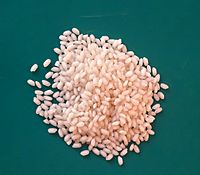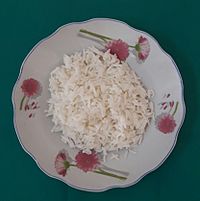Paw hsan hmwe facts for kids
Paw hsan hmwe (Burmese: ပေါ်ဆန်းမွှေး, pronounced: [pɔ̀sʰáɴm̥wé]) is a special kind of aromatic rice from Myanmar. It's also called Paw san hmwe, Pearl Paw San, or Myanmar pearl rice. This rice is famous for its wonderful smell and how well it cooks.
When you cook Paw hsan hmwe, its medium-sized grains can grow up to three times their original length! This makes the rice fluffy and delicious. It has a special quality that makes it a bit firm, which is how people in Myanmar like their rice.
In 2011, Paw San rice was even named the world's best rice at a big conference called the Rice Trader's World Rice Conference. It smells a lot like Jasmine rice from Thailand and gets fluffy and long like Basmati rice from India and Pakistan. Even though it's so good, not much of this rice is sold to other countries. This is because it doesn't grow in huge amounts, and people in Myanmar love it so much that they eat most of it themselves!
Kinds of Paw San Rice
Paw hsan hmwe is a type of Oryza sativa, which is the scientific name for common rice. When people talk about Paw hsan hmwe in the market, they are usually talking about two main kinds:
- Paw hsan gyi (ပေါ်ဆန်းကြီး): This kind is also known as Shwebo paw hsan. It keeps its lovely smell for up to two years if it's harvested and stored correctly.
- Paw hsan yin (ပေါ်ဆန်းရင်): This type has a strong smell, but it fades after about five or six months.
Paw hsan gyi was first developed in 1944. Scientists carefully chose the best Paw san rice plants to create this improved variety.
Where Paw San Rice Grows
Most Paw hsan hmwe rice is grown in the Irrawaddy delta area of Myanmar. This region has rich soil and plenty of water, which is perfect for growing rice. Since the mid-2000s, farmers have also started growing it in other parts of Upper Myanmar.



